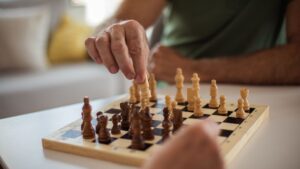Sign-Up For The NeuroGym Newsletter And Join The Innercise Revolution!
We value your privacy and would never spam you.
Featured
Every move you make is the result of many tiny actions that have been programmed into your brain over many years. Movements are the result of learning motor skills.
Do you think about how to walk, hold a pen, or brush your teeth? Probably not, because the movements are well-known to you. It’s something you don’t think about until you engage in an activity that is unfamiliar to your motor cortex.
Imagine learning how to play the trombone or paint with your toes. Those are activities you may not have done before. You might be wondering whether that’s even possible.
It is, but you have to engage your motor cortex and actively learn how to perform the unfamiliar movements.
Learning is something that everyone does throughout their lives, but what about that old saying “you can’t teach an old dog new tricks”? Luckily, science has found this is incorrect—you can learn at any age! However, how easy it is for you to learn something depends on how you stimulate your brain.
In a new study, scientists considered how people acquire motor skills. More specifically, they looked at the difference in learning between young and older individuals.
The scientists already knew that learning abilities decreased with age, but they wanted to determine whether brain stimulation could change these odds.

The easiest way to test motor skills is through exercises requiring finger-tapping.
Finger-tapping refers to any activity where a person needs to use their fingers (a motor movement) to execute an action. For example, typing on a keyboard and playing piano both require finger-tapping.
Examples of finger-tapping exercises include memorizing a sequence of numbers or words and then typing them on a keyboard. Many times, these tasks require that participants use their non-dominant hand as that forces their brains to work even more.
When used as part of a research study, scientists will create a finger-tapping sequence that study participants have to learn. When a person doesn’t know a specific finger-tapping sequence, they have to focus on finger placement, sequencing, and timing.
The result is a trade-off between speed and accuracy. If a person taps the sequence quickly, they are likely to make mistakes. If a person focuses on getting the sequence correct, then it may take them longer to get through it.
Finger-tapping requires the performance of many motor actions to create a sequence. By focussing on which actions follow each other, the brain organizes actions into groups known as “motor chunks.”
Once a person learns motor chunks, the mental load to execute the finger-tapping sequence becomes lighter. Since they no longer have to expend as much energy on remembering the sequence correctly, they can start to work on tapping it faster.
Motor chunks are just one type of building block for the brain that helps it to function properly. When you understand how these building blocks form and work, you take control of your learning.
Get a greater insight into how the brain works and learns by attending the Brain-A-Thon. This life-changing event features top brain experts that will teach you how to learn and work like never before!
Most brain research uses younger participants, but the leaders of this study wanted to include older individuals as well, so they opted for two groups of participants: One consisting of older people and the other of younger individuals.
All participants were given time to learn the finger-tapping sequence during several training sessions. They were then asked to repeat the task the next day to determine the efficiency of the motor chunk. Ideally, participants would first use motor chunks to recall the sequence and focus on speed during subsequent training sessions.
Younger people did better in the finger-tapping task because their brains created motor chunks rapidly.
They focused on memorizing the tapping sequence first so that they could be as accurate as possible. This resulted in motor chunks forming first. After they were comfortable with the sequence, participants worked on increasing the speed at which they performed the task.
The following day, younger participants performed even better which indicates that motor chunks for the finger-tapping task were well established in the brain.
Older participants did not show the same results as their younger counterparts. They struggled to build motor chunks so neither their accuracy nor speed improved rapidly.
Both accuracy and speed only improved once older participants had trained extensively to do the finger-tapping task. Learning was happening at a much slower rate; however, performance decreased overnight and many older participants had to practice more to achieve some kind of task efficiency.

Many studies have been conducted on how brain stimulation can assist with or repair learning abilities, so the researchers refocused their efforts on this possibility.
They applied the noninvasive technique of anodal transcranial direct current stimulation (atDCS) to the motor cortex. atDCS encourages neuronal activity—something that is essential for learning and information transfer between brain cells.
The researchers hypothesized that atDCS should help older people to learn faster—and the results fully supported their hypothesis!
Older participants exposed to atDCS built motor chunks rapidly during the initial finger-tapping training. They remembered the sequence better and executed it with both speed and accuracy. Furthermore, half of the participants experienced this efficiency within the first practice session.
If stimulation through atDCS can be successful, then it’s possible that any kind of mental stimulation will assist with learning at an advanced age.
What’s even better is that this stimulation can happen in your daily life, but do you know how to apply it?
We have the answer and want to share it with you! All you need to do is sign up for the Brain-A-Thon where all will be revealed.
Learning new motor skills is one way to keep your brain young. It forces your mind to build new motor chunks, which is stimulation in itself.
Stimulating your brain also helps you to learn faster so you are more likely to persevere during activities. This is true for all areas of the brain. It even helps to treat addiction.
If you start stimulation exercises while you are young, then you are more likely to maintain a healthy brain. It means you can learn new skills more easily as you age resulting in a better quality of life.
Think about your body for a moment: You have to exercise and eat healthy to keep it in good condition. Mental stimulation does the same for your brain. We like to call this Innercise™.
John Assaraf has created many Innercises™ to work out your brain. When you do so, you activate efficient thinking and change the way you perceive your life. You give yourself permission to do better.
Schedule some time today to do both physical exercise and mental Innercise™. As few as three of each daily can make a noticeable difference.
The benefits are much more than just better thinking. You will also believe in yourself more, boost your productivity, have a more positive outlook on life, and become more confident. It’s a recipe for success that lies within your brain.
By now, you already realize that learning something new is essential for a healthy brain and mental stimulation.
What is something you want to learn?
Jot down a few ideas and choose one thing to start working on in the next month.
Some of our favorite ideas include:
Use today to decide on a skill you want to learn. Commit to the process and create a plan to turn your learning into a habit. Consistent practice will pay off!
This video by John Assaraf explains how success is a result of learning, commitment, and consistency.
Once you learn something successfully, continue to do it. If you get bored or want a challenge, it’s time to select something new to learn.
Your brain craves stimulation so provide it! After all, a healthy brain makes for a healthy life.
The time has come to take control of your life; that starts with taking control of your brain. It’s crucial that you stimulate it constantly, learn new things, and believe in your abilities.
We know it’s easier said than done.
Making time for mental stimulation isn’t a priority for most people. Even worse, many people don’t believe they can change. That’s why we want to show you how it’s done.
We want to convince you that it’s possible to change your brain and your life with a little bit of effort. If you are ready to take control of your life, then the Brain-A-Thon is your answer. You don’t have anything to lose; you just have a lifetime to gain.

NeuroGym Team: NeuroGym’s Team of experts consists of neuroscientists, researchers, and staff who are enthusiasts in their fields. The team is committed to making a difference in the lives of others by sharing the latest scientific findings to help you change your life by understanding and using the mindset, skill set and action set to change your brain.
We value your privacy and would never spam you.